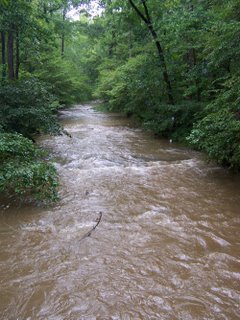Batten Down the Hatches: It’s Hurricane Season

Image: by D L Ennis, storm damage from the most recent hurricane related storm—Ernesto—to pass through the region.
Article by Dave Perault
As hurricane season heats up, it’s a good time to discuss these tropical events and their relevance to the Blue Ridge region. We’ll review their origins and naming, history, and impacts. As with most weather extremes, knowledge is key to understanding and preparing for these types of events.
Hurricanes (also called typhoons and cyclones in other parts of the globe) originate in the tropics where warm oceans, high humidity, and light winds are all ideal conditions for formation. For our region, this tends to occur from June through November (our official hurricane season) throughout the tropical Atlantic, from off the coast of Africa all the way to the Gulf of Mexico. During formation, thunderstorms can converge and, along with falling pressure and counter-clockwise rotation of the air mass, continually build into a higher energy storm. Such storms generally move northwest towards Central and North America, either gaining or losing intensity as conditions change. A tropical disturbance grows into a depression and becomes a storm when its sustained winds reach 39 mph. At this point it is given a pre-assigned name; if it continues to grow with sustained winds reaching 74 mph, it officially becomes a hurricane. Hurricanes are further classified as Category 1-5 based on the Saffir-Simpson Hurricane Scale – also primarily based on wind speed. Tropical storms tend to dissipate as they move north and inland due to cooling, friction, and the loss of warm, moist air.
The naming of hurricanes is as interesting as the storms themselves. Originally, storms were given names based simply on location (lat/long), then letters of the alphabet (Alpha, Bravo . . . ). In 1953 female names began to be used with weathermen sometimes naming storms after their girlfriends (or ex-girlfriends, depending on intensity). In 1978, the current method of alternating between male and female names was adopted, based on a list that repeats every 6 years. Once the end of the list is reached (as happened only once, in 2005), the Greek alphabet is used. Names from especially damaging storms such as Andrew, Hugo, and Katrina are retired.
And there have been some whoppers. In 1900, the worst natural disaster in American history occurred when as many as 10,000 people were killed by a hurricane striking Galveston, Texas. Since then, devastating hurricanes have occurred regularly. One of the most destructive to hit the Blue Ridge was Hurricane Camille in 1969, which dumped as much as 30+ inches of rain overnight in Nelson County, Virginia, and killed well over 100 Virginians. While many think of hurricanes as coastal events, heavy rains inland can cause major flooding throughout the Blue Ridge Mountains.
 Image: by D L Ennis, Flood waters fill the usually gentle flowing, Otter Creek, on the Blue Ridge Parkway as Ernesto is passing through.
Image: by D L Ennis, Flood waters fill the usually gentle flowing, Otter Creek, on the Blue Ridge Parkway as Ernesto is passing through.But hurricanes can also greatly benefit our region. In Virginia, for example, Camille helped to offset drought conditions, and in general such storms can bring highly needed rains to our area. By the time these events reach the Blue Ridge Mountains, their intensity has usually decreased dramatically, with soaking rains often the only remaining impact. Such rains can salvage crops that would otherwise have not survived a dry summer, and replenish dwindling surface and groundwater supplies.
In the end, the impact of a hurricane is dependant on the preparedness of people. As with any natural disaster, staying ready is crucial. In the Blue Ridge this means tracking tropical storm paths, and being prepared for loss of power due to high winds and loss of roads, fields, and houses due to flooding. By staying on top of deteriorating conditions, one can make wise decisions to protect both life and property. Realizing that hurricanes are a recurring part of weather and nature – and planning for them – will help us to both accept and minimize their impacts on our region.
Some good places to learn more about hurricanes include the following web pages:
The Greatest Storms on Earth: http://earthobservatory.nasa.gov/Library/Hurricanes/
National Hurricane Center: http://www.nhc.noaa.gov/
Hurricane Central on the Weather Channel: http://www.weather.com/hurricanecentral/
Wikipedia: http://en.wikipedia.org/wiki/Hurricane
Most of the topics discussed above are explained in more detail on these sites. In addition, C. Donald Ahrens’ Essentials of Meteorology was a valuable source of information.
Dave Perault is an Environmental Science professor at Lynchburg College in Virginia. When not teaching about the environment, he can usually be found outside enjoying it.












0 Comments:
Post a Comment
<< Home